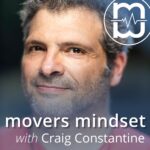
How do the experiences of deafness, architecture, and parkour intersect to influence design and accessibility?
While it’s not immediately apparent that Jade Amber Ragoshke is unilaterally deaf, it is a defining factor for her life and work. She shares her experiences with deafness, learning about it, and adapting to it. Jade discusses architecture and her ongoing research into the connections between architecture, parkour, and accessibility. She reflects on disability, designing for all people, and creating more inclusive environments in all communities.
“I think, after this conversation that we’ve had about art— I think that what art really is, is breaking the boundaries of the standard.” ~ Jade Amber Ragoschke (30:14)
Jade Amber Ragoschke is an architect, parkour practitioner, and the vice president of World Deaf Architecture. Her involvement in parkour led to her interest and eventual career in architecture. After finding her place in the Deaf community, she discovered a new perspective and approach to architecture that is more inclusive, empathetic, and accessible to everyone. Jade specializes in accessible design for people with disabilities and provides architectural consultation to parkour communities. She advocates for inclusive play spaces for all ages and is researching the intersections between architecture, parkour, and accessibility.
This conversation explores the unique intersections of parkour, architecture, and accessibility, weaving together personal experiences and professional insights. Discussions highlight how accessible designs often double as ideal spaces for creative physical movement, reflecting an unexpected synergy between inclusivity and play. Jade emphasizes the importance of designing spaces at a human scale, focusing on sensory experiences and personal engagement rather than purely aesthetic considerations.
The dialogue also examines the philosophical and practical roles of architecture and art in memorializing history and shaping societal experiences. By referencing specific examples like the 9/11 Memorial and other landmark designs, the conversation illustrates how architecture can evoke emotions, honor history, and inspire resilience. The shared experiences of adapting to hearing loss further contextualize Jade’s perspectives on design, emphasizing the transformative potential of inclusivity.
Takeaways
Architecture and human scale — The focus on personal experience in space design emphasizes sensory engagement over aesthetics.
Parkour and accessibility — Accessible spaces unintentionally become ideal settings for creative movement and parkour.
Art and architecture integration — Structures can serve as both functional spaces and artistic installations, enriching urban environments.
Design as inclusivity — Inclusive designs provide comfort and accessibility for all, enhancing the utility of spaces.
Memorializing through design — Architecture captures historical moments, offering spaces for reflection and resilience.
Architectural unpredictability — People often use spaces in unintended ways, revealing the dynamic relationship between design and behavior.
Resources
Jade Amber Ragoschke @antiphase.motion
World Deaf Architecture — Organization focused on accessibility and architecture for Deaf communities.
Bjarke Ingels Group — Architecture firm led by Bjarke Ingels, known for innovative projects like those highlighted in the conversation.
ADA Standards for Accessible Design — Guidelines defining accessibility in architecture.
(Written with help from Chat-GPT.)
— Hello👋 I’m Craig Constantine.
In the Movers Mindset podcast, I talk with movement enthusiasts to learn who they are, what they do, and why they do it. I’m interested in the nature and philosophy of movement and in exploring themes like independence, self-direction, and human excellence. My interests color each conversation and provide some structure to Movers Mindset. But since I like to take the scenic route, every conversation ends up going somewhere unique.
The purpose of Movers Mindset is to create and share great conversations with movement enthusiasts. Each conversation feeds my insatiable curiosity, but I share them to turn on a light for someone else, to inspire them, or to give them their next question.
I appreciate your time and attention, and I don’t take it for granted.
— Thank you!
Want more? Subscribe to the email list for weekly updates—new episodes and archive highlights delivered to your inbox.
I invite you to cultivate a meaningful life—through presence, not pursuit. You can learn more about me and all my projects at, https://craigconstantine.com.
If you like what I’m doing through Movers Mindset, learn more about becoming a patron.
ɕ
